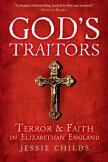Class Matters
As numerous books, films and television series in recent years have demonstrated, there is a fascination, both in the scholarly world and among the wider public, with the Tudor period of English history in general and perhaps with the Elizabethan era in particular. In the context of the fascinating and at times fanatical Europe of the 16th century, with the intersecting currents of the Renaissance, the Reformation and the age of overseas explorations and missionary outreach, England generally overcame certain insular tendencies and interacted with numerous continental developments.
Yet the Tudor response to the European Reformation(s) was particularly idiosyncratic. No other country witnessed such a see-saw as England, moving as it did from so-called “Catholicism without the pope” during the later years of Henry VIII, to the evangelical Protestantism of the brief reign of Edward VI, followed by the reinvigorated Catholicism of the even briefer reign of Mary and finally to the Protestant state church under the “supreme governor,” Elizabeth I. Of particular importance, and unlike her half-siblings, Elizabeth had a long reign of almost 45 years, giving her regime the time, resources and pressure to implant if not impose a relatively permanent religious settlement on the majority of the population.
The response of the Catholic minority varied depending on time, place and circumstances. Jessie Childs has contributed to the growing scholarship on the Catholic Elizabethans with God’s Traitors: Terror and Faith in Elizabethan England. Her interesting approach is to focus on a particular Catholic family, the Vauxes of Harrowden Hall in Northamptonshire, over a series of decades. This prominent family from the Midlands generally tried, like many of their co-religionists, to maintain dual loyalties: to the ancient Catholic faith and the pope on the one hand, and to queen and country on the other. When this proved difficult or nearly impossible, many members of the family were willing to face a series of increasingly severe penalties, including potentially crippling fines.
Nevertheless, it is important to point out, as the author consistently does here, that persecution, however real and devastating it could be, waxed and waned depending on a range of factors, including the national and international political and religious climate, as well as the significant variables of class and gender. Being a woman in a man’s world certainly had its disadvantages, but it could also afford “the weaker sex” some advantages and escape hatches that they could use to their benefit, as Eleanor, Anne and Eliza Vaux discovered. In fact, Queen Elizabeth herself sometimes shrewdly played the gender card!
With regard to distinctions based on class, Elizabethan society, as was the norm in the pre-modern world, was quite hierarchical, and both the nobility and gentry benefitted in various ways from their acclaimed exalted status. What a commoner could or might not get away with, an aristocrat often could. An intriguing example involved the plight of Henry Vaux in the 1580s. Facing crushing fines, he petitioned the crown for forbearance based on an appeal to conscience. Rather surprisingly, Sir William Cecil, Lord Burghley, the queen’s principal advisor, interceded for Lord Vaux. Burghley was known for his strongly anti-Catholic stance, but because of Vaux’s noble status and their shared county connections, Burghley came to the rescue. As Childs aptly comments: “His sympathetic intervention serves as a reminder that no one was predictable in Elizabethan England and nothing was ever quite what it seemed.”
In any event, crucial to the long-term survival of a recusant Catholic community was the pastoral and sacramental role of the clergy. While the secular clergy formed the sizable part of the Catholic priesthood in England, the Jesuits, while relatively small in numbers, exerted considerable influence on the mission as a whole and especially among the upper classes. Childs makes clear how much the Vauxes and the Jesuits depended on each other, the former for spiritual succor and the latter for financial assistance and protection, including often life-saving priest holes. Among the Jesuits, Henry Garnet, the superior of the mission, and John Gerard, perhaps the most successful of the missioners, were particularly well connected with the Vaux circle of family and friends.
Yet even these connections were not always enough. Gerard was captured and tortured, though he managed a daring escape from the Tower of London and eventually went into exile. Garnet, after 20 years of service on the mission, was ensnared, probably unfairly, in the Gunpowder Plot of 1605 and suffered a traitor’s death by being hanged, drawn and quartered. Childs correctly (and cleverly) characterizes Garnet and Gerard as manifesting, respectively, “circumspection and chutzpah.”
Overall, this monograph incorporates a good range of primary and secondary sources, though one could always quibble about some significant sources that are not referred to. The author is up to date about many of the significant historiographical issues and debates, including revisionist views on the creativity of the (short-lived) Marian Catholic revival. Her views, however, concerning the Jesuits’ mindset being largely tied to the “Counter” Reformation and Philip II’s supposed “messianic vision” are too one-dimensional. Still, this is an insightful study of the plight of Elizabethan Catholics using the extended Vaux family as a lens through which to view the heroics and heartaches of being a religious minority in the late 16th century. This expansive case study tells us a lot about both “terror and faith in Elizabethan England.”
This article also appeared in print, under the headline “Class Matters,” in the February 2, 2015, issue.








